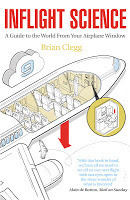Brian Clegg's Blog, page 146
March 9, 2012
Mindstretching time
 Come on, it's Friday. Take a moment to give the leetle grey cells a spot of exercise. (Shut up, Hercule.) You may have heard this problem before. Don't stop reading if it seems familiar, though, we are going way beyond the usual conclusion.
Come on, it's Friday. Take a moment to give the leetle grey cells a spot of exercise. (Shut up, Hercule.) You may have heard this problem before. Don't stop reading if it seems familiar, though, we are going way beyond the usual conclusion.Every morning a man gets into the lift (elevator) on the floor of the high rise block he lives in and rides down to ground level. Every evening he comes home, gets in the lift, rides up to the tenth floor (four floors below his own), gets out and walks the rest of the way. Why?
If you haven't heard it before, think about it for a while before reading on.
P
L
E
A
S
E
T
H
I
N
K
B
E
F
O
R
E
S
C
R
O
L
L
I
N
G
Now an extra piece of information. The man was easily tall enough to reach every button on the lift's control panel. Think about the problem some more. (I throw this in because the conventional 'right' answer is that the man is too short to reach any button higher than the 10th floor. But I'd like to expand your thinking beyond that 'right' answer.)
P
L
E
A
S
E
T
H
I
N
K
B
E
F
O
R
E
S
C
R
O
L
L
I
N
G
There are many possible solutions. The man could want a little exercise, but four floors of stairs are enough. He might suspect his wife of adultery and want to surprise her. He could stop off at a friend's flat four floors below for a drink each evening. And so on. But what if he actually has to get out rather than wants to - surely the conventional solution is now the only one? No. The higher lift buttons could be broken. The owners of the building could charge for each floor you ride up. He only has a ten floor ticket, so he has to walk the rest. Or there is building work going on in the afternoon which restricts the travel of the lift. Feel like arguing with these solutions? The traditional solution is equally frail - whenever there is someone else in the lift, a short person can get to the right floor. Or he could use a stick.
There are two useful lessons here. The first is that a late arriving piece of information can totally change your knowledge base - and it's difficult to give up an established position. The second is to observe just how many solutions there are - and how conditions can be used to question any idea, however valid. And a not so useful lesson - this also demonstrates why Sherlock Holmes style deduction is rubbish: there are always too many variables to strike lucky as often as he does.
If you come across such 'logic problems' in the future, please look for alternative solutions.
Image from Wikipedia
Published on March 09, 2012 08:07
March 8, 2012
E-ink begins to sink
 A Kindle - be honest, does that look exciting?There are reports about that e-book readers are in decline. Apparently Amazon has significantly cut orders of its Kindle e-book reader. This seems strange news, when you consider how we are always hearing that e-books are taking over the world, but I don't find it at all surprising.
A Kindle - be honest, does that look exciting?There are reports about that e-book readers are in decline. Apparently Amazon has significantly cut orders of its Kindle e-book reader. This seems strange news, when you consider how we are always hearing that e-books are taking over the world, but I don't find it at all surprising.I'd say there were two factors at play here. One is that people have increasing availability of other devices like phones and tablets (particularly iPads but also Kindle Fires etc.) that work perfectly well as an e-book reader. It's true that a Kindle has some benefits - it's lighter and it has the e-ink screen which is easier to read outside, and less of a strain on the eyes (not that I find an iPad a strain). But multipurpose mobile devices have become the norm. We no longer want a pure e-book reader, any more than we want a pure mobile phone.
The other factor is that e-ink is dull. I'm sorry, it is. Not only does it show you the world in black and white, it just looks rubbish. Comparing an e-ink screen with an iPad or iPhone screen (* other tablets and smartphones are available) is like comparing reading something printed on an old dot matrix printer with laser printer output. It looks old and tired and grey.
E-readers were the triumph of practicality over style - but consumers are fickle and rarely stick with pure practicality for long. E-ink has begun to sink.
Published on March 08, 2012 08:03
March 7, 2012
My Loch Ness Monster photo
 I ought to say straight away, to avoid any disappointment, that I don't have a photo of the Loch Ness Monster. Sorry. But I do have a picture that I think exhibits some of the features of many LNM (as we scientific types prefer to call Nessie) snaps.
I ought to say straight away, to avoid any disappointment, that I don't have a photo of the Loch Ness Monster. Sorry. But I do have a picture that I think exhibits some of the features of many LNM (as we scientific types prefer to call Nessie) snaps.This is something that I wouldn't have noticed if I hadn't been peering at the picture quite intently. This might seem unlikely, but I happen to have this photo as a desktop background, as a result of which it tends to be in front of my nose quite a lot. And this is the first similarity I suspect with those who find pictures of the LNM (or ghosts or whatever). To do this, people are staring at a picture, in their case hoping to find something.
In my picture (cunningly pretending to be a Polaroid thanks to Picasa) you see a vertical streak of sunlight on the water to the left of the scene. The question is, is there a person in the water, or is that little blob about halfway up the whole image just a rock or an effect of the light? To an LNMologist that might be plenty to report a sighting of the beastie. But what is really there?

In case you think I'm now going to reveal the truth, I haven't a clue. Here's what it looks like in close up and it could well be a person... but it could equally well not be.
For that matter the blob on the left could be another person reclining (though if they are, they either have an enormous head or it's a Sontaran).
I really don't know for certain. And that's the point. Unless it's a fake, the kind of photo that is presented to 'prove' the existence of the LNM (or UFOs) is almost always this kind. One that's easy to interpret as what you want to see. A bit like toast with someone famous's face on it.
So there you have it. My Loch Ness Monster photo. What do you think? Person or not?
Published on March 07, 2012 08:26
March 6, 2012
It's the Bible truth
 It might seem a little odd to review a book of Bible scholarship in a blog that's primarily about science and science writing, but bear with me. This is no normal religious book - and I came to it because it was recommended by no less than Richard Dawkins.
It might seem a little odd to review a book of Bible scholarship in a blog that's primarily about science and science writing, but bear with me. This is no normal religious book - and I came to it because it was recommended by no less than Richard Dawkins.I have to say I found this book, which looks at the way the copying of the New Testament of the Bible introduced errors into it over the years, fascinating. This was for three reasons. First because as a writer. It's remarkable to see such a study of how a series of manuscripts going back a couple of thousand years have accumulated errors and changes. Secondly it really makes you wonder about people who think the Bible is an inerrant source of guidance (Dawkins' main point) and thirdly it shows how some of Christianity's less popular aspects are probably not part of the original version.
Because the book is quite thorough in detail, it helps to really be interested in language and also to have a mild familiarity with the Bible - otherwise it could be a bit of an uphill struggle.
What Ehrman reveals is the way that our translations of the New Testament of the Bible are based on various copied manuscripts and how errors in copying (both accidental and intentional to change the meaning) made various versions drift away from the originals. The detective story of piecing this together is really interesting, especially bearing in mind we don't actually know exactly what the originals said, so textual analysis has to be used to try to pin down what are the changes and what was the earliest version.
This is clearly a body blow for any intelligent person who believes the Bible is the absolute word of God containing no errors. (If that's not an oxymoron.) Such people often take the King James (AV) Bible as their 'absolute truth' version - yet it turns out that the New Testament of this was taken from a single, pretty dubious, late Greek source. It gets lots of things wrong.
I won't go through all the interesting stuff, but one result of reading this is that St Paul has gone up in my estimation. Some of his letters in the Bible make him come across as seriously misogynistic. He appears to say that women shouldn't speak in public and should only do what they are told by their husbands. But it turns out this anti-female stuff was added later by a tinkering scribe who clearly wanted to assert the traditional place of men in society. The original has quite a lot that puts forward women as equals, including naming a female apostle, a female deacon and eminent female members of the congregation. So, sorry St Paul - I got you wrong.
All in all an absorbing read for anyone into the way the written word changes with time and an absolute must for anyone who takes the Bible seriously.
See the book at Amazon.co.uk and Amazon.com.
Published on March 06, 2012 08:48
March 5, 2012
What makes a good bookshop?
 I spent a chunk of Saturday in sunny Brighton a week ago (actually it was raining when I arrived, but let's not be picky). I was giving a talk at the Brighton Science Festival, but then had an excellent chat with one of the owners of an independent bookshop in Brighton, City Books.
I spent a chunk of Saturday in sunny Brighton a week ago (actually it was raining when I arrived, but let's not be picky). I was giving a talk at the Brighton Science Festival, but then had an excellent chat with one of the owners of an independent bookshop in Brighton, City Books.I have to say I was very impressed. Their stand at the festival had an excellent collection of popular science books, and there was such obvious enthusiasm for the product, without the preciousness of some independent bookshops, where the people working there don't seem to even realize they have a product to sell.
I guess that's the downside to the kind of location I live in. With Borders closed, Swindon's only bookshop is Waterstones (I'm afraid I can't count W H Smiths). Our Waterstones is very nice and friendly, but in the end, even under the new regime, they are limited in how much flexibility they can have in what they do. The nearest independent I'm aware of is the White Horse bookshop in Marlborough. It's a lovely little shop, but it's a very local-books-and-stone-circle-lovers (not entirely surprising in Wiltshire), so not really the natural home of a popular science writer.
Running a bookshop is a brave venture in the economic climate booksellers face - I really just wanted to celebrate the fact that those who do it well are true national treasures.
Published on March 05, 2012 09:11
March 2, 2012
The acid that rules your life
 Generally speaking you expect to find really strong acids locked away in the cupboard of a lab. So it may come as something of a shock to find out that one of the big names - hydrochloric acid - plays a big part in your everyday life.
Generally speaking you expect to find really strong acids locked away in the cupboard of a lab. So it may come as something of a shock to find out that one of the big names - hydrochloric acid - plays a big part in your everyday life.Find out why - and much more about this stomach-churning compound - in the latest Royal Society of Chemistry podcast on hydrochloric acid. Click here to listen...
Published on March 02, 2012 08:08
March 1, 2012
The 24 Mystery
 One of the delights of having acquired Netflix (see previous post) is being able to take a look at films and TV shows that caused a big buzz when they came out, but I never got round to seeing. Last night I watched the first two hours of the first season of 24.
One of the delights of having acquired Netflix (see previous post) is being able to take a look at films and TV shows that caused a big buzz when they came out, but I never got round to seeing. Last night I watched the first two hours of the first season of 24.As everyone said at the time, the real time format is very clever and engaging. What's more, how sweet all their antique 'modern' technology is. Jack Bauer is using my old phone! But I desperately need a 24 fan to explain to me the logic of the bad guys in those first couple of episodes.
[SPOILER ALERT]
Okay, it's clever of the writer to make us all think the photographer is the killer to start with. But come on. WHY does the following happen? What the bad guys want to do is replace a top photographer with a ringer, who can then get close to a target and kill them. Fair enough. The photographer is flying in to LA. So they wait for him to get off the plane, kill him and replace him quietly and efficiently? No way.
They blow up the plane with the photographer on in mid-air. So the people involved in this highly secret plot think the best way to keep things secret is to blow up a 747? Nice one, guys.Their evil agent takes the photographer's ID and jumps off the plane before it blows up. Okay, so their ringer can now turn up with a real ID. Great. Only this is real ID for someone the authorities know was blown up on the plane he was arriving on. A little thinking through required here, guys.The evil agent (after sitting around with no clothes on, as she appears to be a naturist), buries the ID with a radio beacon before being taken to their evil lair. About five seconds later (this is real time, remember) someone else on a motorbike with a detector for the radio beacon digs up the ID. This newcomer then hides the ID and extorts money from the rest of the baddies. But why did they bury it and retrieve it seconds later? What possible advantage was there to burying the ID and having it dug up five seconds later?Someone please explain!
Image from Wikipedia
Published on March 01, 2012 07:22
February 29, 2012
Oh for the wings of a dove
 I do quite a lot of talks based on my book
Inflight Science
, and one thing that is guaranteed to raise a bit of an argument is when I cover how wings work.
I do quite a lot of talks based on my book
Inflight Science
, and one thing that is guaranteed to raise a bit of an argument is when I cover how wings work.If we were taught anything about the reason why wings lift a plane at school, it is likely to be down to the Bernoulli principle. This is great, because it's really easy to demonstrate. Just get yourself a bit of paper (say about 1/4 of a sheet of A4 or Letter), hold it at one end so it droops and blow over the top of it. The droopy bit rises up as it experiences lift. And that's how a wing works, we're told! Only, it isn't.
 DIY BernoulliWhen you blow over the bit of paper you get the air moving over the top of it, thinning it out a little. So there's less pressure on the top than the bottom (where the air isn't moving), and you get lift. That's the Bernoulli effect.
DIY BernoulliWhen you blow over the bit of paper you get the air moving over the top of it, thinning it out a little. So there's less pressure on the top than the bottom (where the air isn't moving), and you get lift. That's the Bernoulli effect.A wing is different, of course. The air is moving over the top and the bottom. The explanation usually given is that the wing is specially shaped so the air has further to go over the top than it does under the bottom. So the top air has to speed up to catch up with the bottom air. Reduced pressure, lift, Bob's your uncle. But when you think about it, this is daft. Why should the air going over the top care about keeping up with the air going under the bottom. It's not like the molecules are best mates and desperately need to keep together.
Fluid flow is altogether more complex than this. As it happens the air does go faster over the top, and there is a Bernoulli effect, but it has nothing to do with trying to keep up with the air going under the bottom. And the lift from the Bernoulli effect is nowhere near enough to get a plane into the air. Instead, what does the trick is Newton's third law of motion. The wing is shaped so that as it cuts through the air, it pushes the air downwards. Push the air down and that pushes the wing up. Exactly the same principle as the jet engine uses to get the plane moving in the first place.
So by all means have fun blowing over bits of paper. It is strangely comforting. But it's not how planes get into the sky.
Published on February 29, 2012 09:51
February 28, 2012
Is my book blaspheming?
 One of my best selling books is
The God Effect
, which describes the truly remarkable phenomenon of quantum entanglement.
One of my best selling books is
The God Effect
, which describes the truly remarkable phenomenon of quantum entanglement.I do sometimes wonder if some of the sales of the book arise not from an interest in quantum physics, but rather because it sounds like a slightly wacky religious book. That was certainly never my intention, though obviously I wanted it to have an eye-catching title.
The name was inspired by Nobel Prize winner Leon Lederman's nickname for the Higgs boson, 'the God particle.' It's possible to look at the mechanism this hypothetical particle is thought to give other particles mass as a kind of entanglement, so it seemed reasonable to call entanglement 'the God effect', especially as entanglement does produce such remarkable outcomes. I really don't think it was hyperbole to subtitle the book 'science's strangest phenomenon.'
 I now learn from New Scientist that Lederman originally refered to the Higgs boson as 'the goddam particle' rather than 'the God particle' - but his publishers didn't like this apparently blasphemous term, so they changed the name and came up with 'the God particle' instead.
I now learn from New Scientist that Lederman originally refered to the Higgs boson as 'the goddam particle' rather than 'the God particle' - but his publishers didn't like this apparently blasphemous term, so they changed the name and came up with 'the God particle' instead.If this is true, I have to face up to the fact that my book really should have been called The Goddam Effect, which somehow doesn't quite give the feel I was aiming for. Though it would be quite amusing. And, to be honest, I feel it would have been better than just calling it Quantum Entanglement as the book nearly was.
Published on February 28, 2012 12:07
February 27, 2012
Protecting the enhanced life
 A pocket computerEvery now and then someone proudly produces a ten-year-old mobile phone and announces that they have no need for modern technology. 'It makes phone calls and it texts,' they say. 'What more do I need?' But they miss the point.
A pocket computerEvery now and then someone proudly produces a ten-year-old mobile phone and announces that they have no need for modern technology. 'It makes phone calls and it texts,' they say. 'What more do I need?' But they miss the point.As the organizers of the Mobile World Congress are quick to highlight, mobile technology is far more than just phoning on the move. It's for books, monitoring health, navigation, making payments and connecting with friends. It might involve a Kindle or an iPad, a GPS device or a widget to give keyless access to your car. For the moment, though, the smartphone is the most significant device – and this is where our smug old technology owner misses the point. A smartphone isn't a mobile phone that does some other fancy stuff. It's a genuine, accept no substitutes, pocket computer (as mentioned in the Blondie song – about 2' 41'' in the video) that happens to be a phone as well.
At one point most technology pundits would have told you the PDA (Personal Digital Assistant) was the way forward. I would have been one of them. It seemed impossible to cram everything you needed for a viable pocket computer into the form factor of a phone. Yet that's exactly what a smartphone does. I reckon about 20 percent of the usage and about 5 percent of the value I get out of my iPhone is making phone calls and texts. The rest is much richer.
If I look at my mobile phone usage over a week, yes there will be calls and texts. But I will also have listened to music, found where I was (and how to get somewhere else) on maps, dropped into social networks, looked up information online, played a couple of games, read a few documents, located my nearest favourite coffee shop (and found out when it was open), paid for a coffee, looked up a friend's address, repeatedly used my diary and made a few notes. Oh and used it to take some photographs too. Not to mention deploying it as a torch.
I don't think it's exaggerating to say that the phone in your pocket has the potential to enhance your life. It's a small scale human upgrade, without the need for a Matrix-style socket in the back of your neck. That's quite some power provided by that tiny pocketable box. But, as Spiderman so wisely observed, with great power comes great responsibility. What happens if I lose my smartphone? Or drop it? Or have to use it in the rain? There's a whole lot of disaster waiting to happen if I put so much of my life in the hands of an all-too-frail device.
There are broadly two things I need to protect to ensure that my mobile life remains smooth – my data and my way of getting to it. Until recently, the data was the key. It's a pain, but I can get another phone. If I lose my data, though – addresses, diary, photographs, music – it's gone for ever. But now the reality has flipped. Increasingly the data isn't on the phone, it's in the Cloud. There isn't a single bit of significant data on my phone now that isn't either replicated or coming direct from the internet. But if my phone stops working when I'm using it to find my way across a city, I won't be happy.
I would never use a phone without a case. The best smartphones look very pretty, but I'd rather cut down the visual wow factor in exchange for protection. So far so good. But when I use my phone outside I'm also challenged by the British weather. Electronics and water don't go together particularly well (as my daughters have discovered when they respectively dropped a cup of tea and a glass of orange juice over their laptops). Standing in the rain trying to follow a map or send a tweet (both of which I've done) is a scary business.
You could put the whole thing in a waterproof casing, like an underwater camera – but that swings the balance too far the other way, rendering the device impractical. Instead I would dearly love my phone to have the ability to repel water, a super power that does apply to at least one smartphone, Motorola's new Razr. If I'm honest, it's not a phone I'd buy, but Apple please take note – I want that protection.
The Razr uses a technology called Splash-Guard developed by P2i. It's an interesting application of nanotechnology, incorporating a coating applied using a plasma. Plasmas are fascinating – the fourth state of matter, next up the scale after a gas. It's bizarre that we don't meet them sooner at school, as plasmas account for around 99 percent of the universe's detectable matter, and are much more obvious than gasses because they often glow. Where a gas is a collection of atoms or molecules, a plasma is a collection of ions – atoms that are energetic enough to have lost or gained electrons and become charged. Stars are mostly plasma, and flames usually contain plasma.
The technology bonds to the phone and its internal components at a molecular level, producing a coating that causes liquid to form into droplets and roll off. You can see how it's applied in their process video (a bit corporate, but bear with it).
I really want this stuff on my phone. This video shows just what it does very nicely:
Does this mean if I have a suitably protected device in the future I'm going to be happy standing in the pouring rain using it? Probably not. I will always be a little wary. But surely it makes sense, when so much of your everyday business depends on something as potentially fragile as a smartphone, to do what you can to protect it? Smartphone manufacturers take note.
Published on February 27, 2012 15:30



